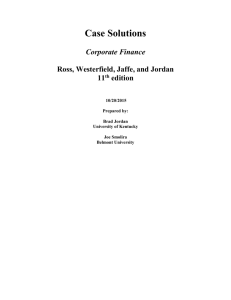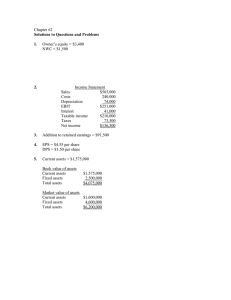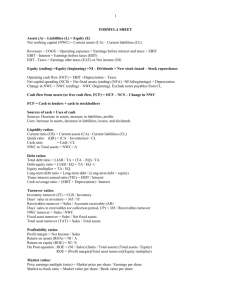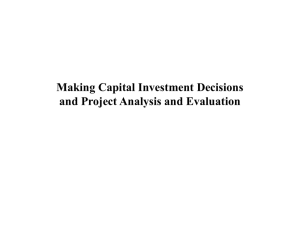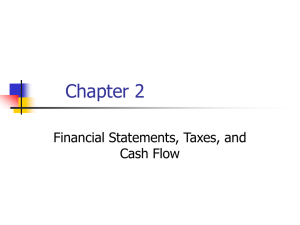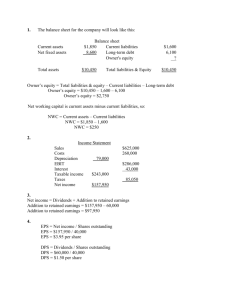CHAPTER 2 FINANCIAL STATEMENTS, TAXES, AND CASH FLOWS
advertisement
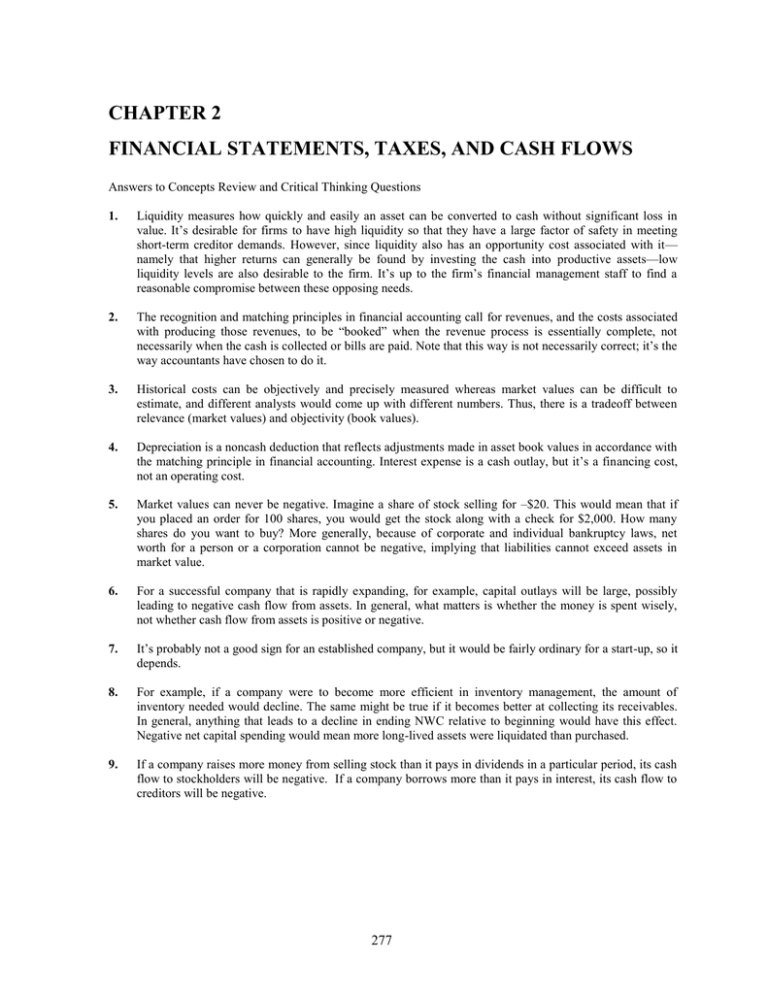
CHAPTER 2 FINANCIAL STATEMENTS, TAXES, AND CASH FLOWS Answers to Concepts Review and Critical Thinking Questions 1. Liquidity measures how quickly and easily an asset can be converted to cash without significant loss in value. It’s desirable for firms to have high liquidity so that they have a large factor of safety in meeting short-term creditor demands. However, since liquidity also has an opportunity cost associated with it— namely that higher returns can generally be found by investing the cash into productive assets—low liquidity levels are also desirable to the firm. It’s up to the firm’s financial management staff to find a reasonable compromise between these opposing needs. 2. The recognition and matching principles in financial accounting call for revenues, and the costs associated with producing those revenues, to be “booked” when the revenue process is essentially complete, not necessarily when the cash is collected or bills are paid. Note that this way is not necessarily correct; it’s the way accountants have chosen to do it. 3. Historical costs can be objectively and precisely measured whereas market values can be difficult to estimate, and different analysts would come up with different numbers. Thus, there is a tradeoff between relevance (market values) and objectivity (book values). 4. Depreciation is a noncash deduction that reflects adjustments made in asset book values in accordance with the matching principle in financial accounting. Interest expense is a cash outlay, but it’s a financing cost, not an operating cost. 5. Market values can never be negative. Imagine a share of stock selling for –$20. This would mean that if you placed an order for 100 shares, you would get the stock along with a check for $2,000. How many shares do you want to buy? More generally, because of corporate and individual bankruptcy laws, net worth for a person or a corporation cannot be negative, implying that liabilities cannot exceed assets in market value. 6. For a successful company that is rapidly expanding, for example, capital outlays will be large, possibly leading to negative cash flow from assets. In general, what matters is whether the money is spent wisely, not whether cash flow from assets is positive or negative. 7. It’s probably not a good sign for an established company, but it would be fairly ordinary for a start-up, so it depends. 8. For example, if a company were to become more efficient in inventory management, the amount of inventory needed would decline. The same might be true if it becomes better at collecting its receivables. In general, anything that leads to a decline in ending NWC relative to beginning would have this effect. Negative net capital spending would mean more long-lived assets were liquidated than purchased. 9. If a company raises more money from selling stock than it pays in dividends in a particular period, its cash flow to stockholders will be negative. If a company borrows more than it pays in interest, its cash flow to creditors will be negative. 277 Solutions to Questions and Problems Basic 1. CA NFA TA 2. $3,000 6,000 $9,000 Balance Sheet CL LTD OE TL + OE $900 5,000 3,100 $9,000 OE = $9,000 – 5,900 = 3,100 NWC = $3,000 – 900 = $2,100 Income Statement Sales $432,000 Costs 210,000 Depreciation 25,000 EBIT $197,000 Interest 8,000 EBT $189,000 Taxes 66,150 Net income $122,850 add. to ret. earnings = $122,850 – 65,000 = $57,850 3. Net income = divs + add. to ret. earnings; 4. EPS = NI / shares DPS = divs / shares 5. NWC = CA – CL; CA = $900K + 1.8M = $2.7M Book value CA = $2.7M Market value CA = $2.9M Book value NFA = $1.6M Market value NFA = $1.5M Book value assets= $2.7M + 1.6M = $4.3M Market value assets = $122,850 / 30,000 = $4.10 per share = $65,000 / 30,000 = $2.17 per share 6. Tax bill = .1862 x $185,000 = $34,447 7. Average tax rate = marginal tax rate = 18.62% 8. Federal tax $31,677 x .17 = ($63,354 – 31,678) x .22 = ($103,000 – 63,355) x .26 = ($185,000 – 103,001) x .29 = Total Federal tax = $5,385.09 6,968.72 10,307.70 23,779.71 $46,441.22 Provincial tax $31,892 x .0605 = ($63,786 – 31,893) x .0915 = ($185,000 – 63,787) x .1116 = Total Provincial tax = $1,929.47 2,918.21 13,527.37 $18,375.05 = $2.9M + 1.5M = $4.4M Total tax = $46,441.22 + $18,375.05 = $64,816.27 Advantage to incorporate = $64,816.27– 34,447.00 = $30,369.27 9. Income Statement Sales Costs Depreciation EBIT $9,750 5,740 1,000 $3,010 278 OCF = EBIT + D – T = $3,010 + 1,000 – 969.50 = $3,040.50 Interest Taxable income Taxes (35%) Net income 240 $2,770 969.50 $1,800.50 10. Net capital spending = NFAend – NFAbeg + depreciation = $3.5M – 3.1M + 850K = $1.25M 11. Change in NWC 12. Cash flow to creditors = interest paid – net new borrowing = $400K – (LTDend – LTDbeg) = $400K – ($3.6M – 3.1M) = $400K – 500K = – $100K 13. Cash flow to stockholders = Dividends paid – Net new equity = 500K – [ ( Commonend + APISend) – ( Commonbeg + APISbeg) ] = $500K – [(825K + 7.8M) – (750K + 7.2M)] = $500K – [8.625M – 7.950M] = –$175K 14. Cash flow form assets = cash flow to creditors + cash flow to stockholders =-100K-175K=-$275K Cash flow from assets = -$275K= OCF–change in NWC–net capital spending = OCF+$195K-$600K=-$275K Operating cash flow = -275K-195K+600K=$130K 15. Income Statement Sales Costs Gross margin Other expenses EBDIT Depreciation EBIT Interest Taxable income Taxes Net income Dividends Addition to ret. Earnings = NWCend – NWCbeg = (CAend – CLend) – (CAbeg – CLbeg) = ($1,440 – 525) – ($1,200 – 720) = $915 – 480 = $435 $130,000 82,000 $48,000 3,500 $44,500 6,000 $38,500 14,000 $24,500 8,330 $16,170 6,400 $9,770 a. OCF = EBIT + D - T = 38,500 + 6,000 - 8,330 = $36,170 b. CFC = interest -net new LTD = 14,000 6,000 = $20,000 c. CFS = dividends -net new equity = 6,400 -2,830 = $3,570 d. CFA = CFC+CFS = 20,000+3,570 = $23,570 23,570 = OCF -net cap. sp. - change in WC; net cap. sp. inc. in NFA depreciation 5,000 6,000 $11,000 Change in NWC OCF - net cap. sp. - CFA 36,170-11,000-23,570 $1,600 16. Net income = dividends + addition to ret. earnings = 800 + 4,000 = $4,800 EBT = NI / ( 1– tax rate) = 4,800 / 0.65 = $7,384.62 EBIT = EBT + interest = 7,384.62 + 1,200 = $8,584.62 Sales – costs = EBDIT = 21,000 – 10,000 = $11,000 Depreciation = EBDIT – EBIT = 11,000 – 8,584.62 = $2,415.38 17. Cash Balance Sheet $300,000 Accounts payable 279 $700,000 Accounts receivable Inventory Current assets Tangible net fixed assets Intangible net fixed assets Total assets 150,000 425,000 $875,000 3,500,000 775,000 $5,150,000 Notes payable Current liabilities Long-term debt Total liabilities 145,000 $845,000 1,300,000 $2,145,000 Common stock Accumulated ret. earnings Total liab. & owners’ equity ?? 2,150,000 $5,150,000 ?? = $5,150,000 – 2,150,000 – 2,145,000 = $855,000 Common stock is a plug figure that makes Total assets equal to Total liabilities & owners’ equity 18. Owners’ equity = Max [(TA – TL), 0]; a. if TA = $3,600, OE = $700; b. if TA = $2,300, OE = $0 19. a. Corporation growth: Taxes = (0.1862)($80,000) = $14,896 Corporation income: Taxes = (0.3662)($9M) = $3,295,800 The firms have different marginal tax rates. Corporation growth pays an additional$1,862 of taxes and in general pays 18.62% of its next dollar in taxes. Corporation income pays $3,662 of additional taxes and in general pays 36.62% of its next dollar in taxes. b. 20. a. 21. Sales COGS A&S expenses Depreciation EBIT Interest Taxable income Taxes (35%) Net income Income Statement $900,000 600,000 170,000 105,000 $25,000 85,000 ($60,000) 0 ($60,000) b. OCF = EBIT + D – T = $25,000 + 105,000 – 0 = $130,000 c. Net income was negative because of the tax deductibility of depreciation and interest expense. However, the actual cash flow from operations was positive because depreciation is a non-cash expense and interest is a financing, not an operating, expense. A firm can still pay out dividends if net income is negative; it just has to be sure there is sufficient cash flow to make the dividend payments. Change in NWC = net cap. sp. = net new equity = 0. (Assumed) Cash flow from assets = OCF – change in NWC – net cap. sp. = $130K – 0 – 0 = $130K Cash flow to stockholders = dividends – net new equity = $25K – 0 = $25K Cash flow to creditors = cash flow from assets – cash flow to stockholders = $130K – 25K = $105K Cash flow to creditors = interest – net new LTD; Net new LTD = interest – cash flow to creditors = $85K – 105K = –$20K 22. a. Income Statement Sales $12,200 Cost of good sold 9,000 Depreciation 1,600 EBIT $1,600 Interest 200 Taxable income $1,400 Taxes (34%) 476 Net income $924 b. c. OCF = EBIT + D – T = $1,600 + 1,600 – 476 = $2,724 Change in NWC = NWCend – NWCbeg = (CAend – CLend) – (CAbeg – CLbeg) = ($3,100 – 1,800) – ($2,000 – 1,500) = $1,300 – 500 = $800 Net cap. sp. = NFAend – NFAbeg + D = $8,400 – 8,000 + 1,600 = $2,000 CFA = OCF – change in NWC – net cap.sp = $2,724 – 800 – 2,000 = –$76 The cash flow from assets can be positive or negative, since it represents whether the firm raised funds or distributed funds on a net basis. In this problem, even though net income and OCF are 280 positive, the firm invested heavily in both fixed assets and net working capital; it had to raise a net $76 in funds from its stockholders and creditors to make these investments. d. 23. a. b. c. d. = interest – net new LTD = $200 – 0 = $200 = cash flow from assets – cash flow to creditors = –$76 – 200 = –$276 = dividends – net new equity; Net new equity = $300 + 276 = $576 The firm had positive earnings in an accounting sense (NI > 0) and had positive cash flow from operations. The firm invested $800 in new net working capital and $2,000 in new fixed assets. The firm had to raise $76 from its stakeholders to support this new investment. It accomplished this by raising $576 in the form of new equity. After paying out $300 of this in the form of dividends to shareholders and $200 in the form of interest to creditors, $76 was left to just meet the firm’s cash flow needs for investment. Cash flow to creditors Cash flow to stockholders Total assets 2002 = $625 + $2,800 = $3,425; total liabilities 2002 = $245 + 1,400 = $1,645 Owners’ equity 2002 = $3,425 – 1,645 = $1,780 Total assets 2003 = $684 + 3,100 = $3,784; total liabilities 2003 = $332 + 1,600 = $1,932 Owners’ equity 2003 = $3,784 – 1,932 = $1,852 NWC 2002 = CA02 – CL02 = $625 – 245 = $380 NWC 2003 = CA03 – CL03 = $684 – 332 = $352 Change in NWC 2003 = NWC03 – NWC02 = $352 – 380 = –$28 Net cap. sp. = NFA03 – NFA02 + D03 = $3,100 – 2,800 + 700 = $1,000 Net cap. sp. = fixed assets bought – fixed assets sold $1,000 = $1,500 – fixed assets sold; fixed assets sold = $1,500 – 1,000 = $500 EBIT = Sales – costs – depreciation = $8,100 – 3,920 – 700 = $3,480 EBT = EBIT – interest = $3,480 – 212 = $3,268; Tax = EBIT .35 = $3,268 .35 = $1,143.80 OCF03 = EBIT + Dep – Taxes = $3,480 + 700 – 1,143.80 = $3,036.20 Cash flow from assets = OCF – inc. in NWC – net cap. sp. = $3,036.20 – (–28) – 1,000 = $2,064.20 Net new borrowing = LTD03 – LTD02 = $1,600 – 1,400 = $200 Cash flow to creditors = interest – net new LTD = $212 – 200 = $12 Net new borrowing = $200 = debt issued – debt retired; debt retired = $300 – 200 = $100 24. DIVIDENDS Dividend Gross up (25%) Federal Tax (29%) Dividend Tax Cred. Federal Tax Prov. Tax (10%) Tax Payable $20,000 5,000 25,000 7,250 -3,333 $3,917 2,000 $5,917 INTEREST Interest Federal Tax (29%) Prov. Tax (10%) $10,000 2,900 1,000 Tax Payable $3,900 Cash Flow from Dividends = $20,000 – $5,917 = $14,083 Cash Flow from Interest = $10,000 – $3,900 = $6,100 Cash Flow from Capital Gains = $10,000 – $1,950 = $8,050 Challenge 25. Inc. in cap. sp. = NFAend – NFAbeg + D = (NFAend – NFAbeg) + (D + ADbeg) – ADbeg 281 CAPITAL GAINS Capital Gain Fed. Tax (1/2 x 29%) Prov. Tax (1/2 x10%) Tax Payable $10,000 1,450 500 $1,950 = (NFAend – NFAbeg)+ ADend – ADbeg = (NFAend + ADend) – (NFAbeg + ADbeg) = FAend – FAbeg. 26. Cash A/R Inventory CA NFA TA 12/31/02 Balance Sheet $1,075 A/P 1,423 N/P 2,530 CL $5,028 LTD 9,015 OE $14,043 TL&E $1,129 208 $1,337 3,600 9,106 $14,043 2002 Income Statement Sales Costs Gross margin Other expenses EBDIT Depr EBIT Interest EBT Taxes@40% Net income Dividends Add. to RE 27. 12/31/03 Balance Sheet $1,099 A/P 1,603 N/P 2,600 CL $5,302 LTD 9,230 OE $14,532 TL&E 2003 Income Statement $2,050.00 705.00 $1,345.00 170.00 $1,175.00 295.00 $880.00 137.00 $743.00 297.20 $445.80 250.00 $195.80 2003: Cash A/R Inventory CA NFA TA Sales Costs Gross margin Other expenses EBDIT Depr EBIT Interest EBT Taxes@40% Net income Dividends Add. to RE $2,200.00 801.00 $1,399.00 140.00 $1,259.00 295.00 $964.00 158.00 $806.00 322.40 $483.60 275.00 $208.60 OCF = EBIT + D – T = $964 + 295 – 322.40 = $936.60 Change in NWC = NWCend – NWCbeg = (CA – CL)end – (CA – CL)beg = ($5,302 – 1,290) – (5,028 – 1,337) = $4,012 – 3,691 = $321 Net cap. sp. = NFAend – NFAbeg + Dep. = $9,230 – 9,015 + 295 = $510 Cash flow from assets = OCF – Change in NWC – Net cap. sp. = $936.60 – 321 – 510 = $105.60 Cash flow to creditors = Interest – Net new LTD; Net new LTD = LTDend – LTDbeg Cash flow to creditors = $158 – (4,200 – 3,600) = –$442 Net new equity = Common stockend – Common stockbeg Common stock + Retained earnings = Total owners’ equity Net new equity = (OE – RE)end – ( OE – RE)beg = OEend – OEbeg + REbeg – REend REend = REbeg + Add. to RE03 Net new equity = OEend – OEbeg + REbeg – (REbeg+ add. to RE03) = OEend – OEbeg – ARE03 Net new equity = 9,042 – 9,106 – 208.60 = –$272.60 Cash flow to stockholders = Divs – Net new equity = $275 – ( –272.60) = $547.60 As a check: Cash flow from assets = $105.60 = Cash flow from creditors + Cash flow to stockholders = –$442 + 547.60 = $105.60 282 $1,095 195 $1,290 4,200 9,042 $14,532 28. a. b. c. 29. Year 1 2 3 4 5 After Tax Rate of Return on Dividends After Tax Rate of Return on Interest After Tax Rate of Return on Capital Gains Beginning UCC $1,250,000* $2,187,500 $1,640,625 $1,230,468.75 $922,851.56 = 23.47% = 10.17% = 13.42% 25% CCA $312,500 $546,875 $410,156.25 $307,617.19 $230,712.89 Ending UCC $937,500 $1,640,625 $1,230,468.75 $922,851.56 $692,138.67 20% CCA $51,400 $92,520 $74,016 $59,212.80 $47,370.24 Ending UCC $205,600 $370,080 $296,064 $236,851.20 $189,480.96 *50% of $2,500,000 30. Year 1 2 3 4 5 Beginning UCC $257,000* $462,600 $370,080 $296,064 $236,851.20 *50% of $514,000 31. Year 1 2 3 4 5 Beginning UCC $150,000* $255,000 $178,500 $64,950 $45,465 30% CCA $45,000 $76,500 $53,550 $19,485 $13,639.50 Ending UCC $105,000 $178,500 $64,950** $45,465 $31,825.50 *50% of $300,000 **($178,500)(0.7) – (0.20) ($300,000) = $64,950 If the asset class is continued, there will be no tax consequences - the after-tax proceeds from sale will be $300,000 x .20 = $60,000. 32. CCA on equipment Year 2002 2003 Beginning UCC $1,100,000* $1,980,000 20% CCA $220,000 $396,000 Ending UCC $880,000 $1,584,000 *50% of $2,200,000 (includes the installation cost) CCA on building Year 2002 2003 Beginning UCC $1,000,000* $1,950,000 5% CCA $50,000 $97,500 Ending UCC $950,000 $1,852,500 50% CCA Ending UCC *50% of $2,000,000 CCA for 2002 = $270,000 CCA for 2003 = $493,500 33. Year Beginning UCC 283 1999 2000 2001 2002 2003 $112,500* $168,750 $84,375 $432,187.50** $216,093.75 $56,250 $84,375 $42,187.50 $216,093.75 $108,046.88 $56,250 $84,375 $42,187.50 $216,093.75 $108,046.88 *50% of $225,000 **UCC2002 = 0.5 (875,000 – 95,000) + $42,187.50 = $432,187.50 34. a. Federal tax = 0.29($57,000)(0.06) = $991.80 Provincial tax = 0.10($57,000)(0.06) = $342.00 After tax income = $3,420 – $991.80 – $342.00 = $2,086.20 b. Federal tax on dividends = 1.25($20)(250)(0.29 – 0.1333) = $979.38 Provincial tax on dividends = ($20)(250)(0.10) = $500 After tax income = $20(250) – $979.38 – $500 = $3,520.62 c. Federal tax on capital gain = $10(500)(0.5)(0.29) = $725 Provincial tax on capital gain = $10(500)(0.5)(0.10) = $250 After tax income = $5,000 – $725 – $250 = $4,025.00 35. Carry the loss back 3 years and the remaining loss is carried forward 7 years: (in 1,000's) Total carry backs = $116 + $140 + $168 = $424 leaving ($600 – $424) to carry forward which effectively reduces taxable income to zero for all years through 2003. At that time, remaining carryforward is $56. 36. a. b. UCC0=79,400(1/2) = 39,700 CCA1=11,910 UCC1=67,490 UCC5=67,490(1-.30)4 = $16,204.35 Since the asset has no value and the asset pool remains open, there are no tax consequences. 284
